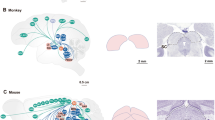Summary
A semi-intact eye cup preparation was developed which maintains visual responses and enables intracellular recordings to be made from the optic lobes of the crayfish compound eye.
-
1.
Sustaining fibers (SFs) were impaled with lucifer yellow electrodes near their entrance to the second optic neuropil (where the SFs originate).
-
2.
Corneal receptive fields were determined and the SFs identified based on the previous work of Wiersma and Yamaguchi (1966). Following identification of each cell, the dendritic morphology was observed with lucifer yellow iontophoresis and subsequent fluorescence microscopy (Fig. 2).
-
3.
An individual SF possesses a dendritic arborization restricted to that portion of the medulla corresponding to its corneal receptive field (Fig. 3). Therefore, the position of the dendritic tree combined with the retinotopic organization within the distal optic neuropils determine each SF's visual receptive field.
Similar content being viewed by others
Abbreviations
- SFs :
-
sustaining fibers
- EPSPs :
-
excitatory postsynaptic potentials
References
Ache BW, Sandeman DC (1980) Olfactory-induced central neural activity in the murray crayfish,Eusastacus armatus. J Comp Physiol 140:295–301
Barrera-Mera B, Berdeja-Garcia GY (1979) Bilateral effects on retinal shielding pigments during monocular photic stimulation in the crayfish,Procambarus. J Exp Biol 79:163–168
Bishop CA, Bishop LG (1981) Vertical motion detectors and their synaptic relations in the third optic lobe of the fly. J Neurobiol 12:281–296
Eckert H, Bishop LG (1978) Anatomical and physiological properties of the vertical cells in the third optic ganglion ofPhoenicia sericata (Diptera, Calliphoridae). J Comp Physiol 126:57–86
Glantz RM (1971) Peripheral versus central adaptation in the crustacean visual system. J Neurophysiol 34:485–492
Glantz RM (1973) Spatial integration in the crustacean visual system: Peripheral and central sources of non-linear summation. Vision Res13:1801–1814
Glantz RM (1974) Defense reflex and motion detector responsiveness to approaching targets: The motion detector trigger to the defense reflex pathway. J Comp Physiol 95:297–314
Glantz RM, Kirk MD (1980) Intercellular dye migration and electronic coupling within neuronal networks of the crayfish brain. J Comp Physiol 140:121–133
Glantz RM, Wood H (1978) The coding and decoding of visual information by patterned pulse trains in the crayfish visual system in the steady state condition. In: Cool SJ, Smith EL, III (eds) Frontiers in visual science. Springer, Berlin Heidelberg New York, pp 490–502
Hafner GS (1973) The neural organization of the lamina ganglionaris in the crayfish: A Golgi and EM study. J Comp Neurol 152:255–280
Harreveld A, Van (1936) A physiological solution for fresh-water Crustacea. Proc Soc Exp Biol Med 34:428–432
King DG (1976) Organization of crustacean neuropil. II. Distribution of synaptic contacts on identified motoneurons in lobster stomatogastric ganglion. J Neurocytol 5:239–266
Kirk MD, Glantz RM (1981) Morphological representation of crayfish sustaining fiber visual fields. Neurosci Abstr 7:251
Krasne FB, Stirling CA (1972) Synapses of crayfish abdominal ganglia with special attention to afferent and efferent connections of the lateral giant fibers. Z Zellforsch 127:526–544
Mellon Jr D, Lorton ED (1977) Reflex actions of the functional divisions in the crayfish oculomotor system. J Comp Physiol 121:367–380
Nässel DR (1977) Types and arrangements of neurons in the crayfish optic lamina. Cell Tissue Res 179:45–75
Nässei DR, Waterman TH (1977) Golgi EM evidence for visual information channeling in the crayfish lamina ganglionaris. Brain Res 130:556–563
Ogden T, Citron M, Pierantoni R (1978) The jet stream microbeveler: An inexpensive way to bevel ultrafine glass micropipettes. Science 201:469–470
Parker GH (1895) The retina and optic ganglia in decapods, especially inAstacus. Mitt Zool Stat (Neapel) 12:1–73
Shivers RR (1967) Fine structure of crayfish optic ganglia. Univ Kansas Sei Bull 47:677–733
Stewart WW (1978) Functional connections between cells as revealed by dye-coupling with a highly fluorescent naphthalimide tracer. Structure, physical properties of lucifer yellow. Cell 14:741–759
Stowe S (1977) The retina-lamina projection in the crabLeptograpsus variegatus. Cell Tissue Res 185:515–525
Strausfeld NJ (1976) Atlas of an insect brain. Springer, Berlin Heidelberg New York
Strausfeld NJ, Nässei DR (1981) Neuroarchitectures serving compound eyes of Crustacea and insects. In: Autrum H (ed) Handbook of sensory physiology, vol VII 6 B. Springer, Berlin Heidelberg New York, pp 1–132
Taylor RC (1974) A saline transfusion technique for crayfish CNS studies. Comp Biochem Physiol [A] 47:1185–1190
Waldrop B, Glantz RM (1980) Localization of dendritic fields and terminal arborization in sustaining fibers of the crayfish visual system. Neurosci Abstr 6:221
Waterman TH, Wiersma CAG, Bush BMH (1964) Afferent visual responses in the optic nerve of the crab,Podophthalmus. J Cell Comp Physiol 63:135–155
Wiersma, CAG, Yamaguchi T (1966) The neuronal components of the optic nerve of the crayfish as studied by single-unit analysis. J Comp Neurol 128:333–358
Wiersma CAG, Roach JLM, Glantz RM (1982) Neural integration in the optic system. In: Atwood HL, Sandeman DC (eds) Biology of Crustacea. Academic Press, New York
Woodcock AE, Goldsmith TH (1973) Differential wavelength sensitivity in the receptive fields of sustaining fibers in the optic tract of the crayfishProcambarus. J Comp Physiol 87:247–257
Author information
Authors and Affiliations
Rights and permissions
About this article
Cite this article
Kirk, M.D., Waldrop, B. & Glantz, R.M. The crayfish sustaining fibers. J. Comp. Physiol. 146, 175–179 (1982). https://doi.org/10.1007/BF00610235
Accepted:
Issue Date:
DOI: https://doi.org/10.1007/BF00610235




